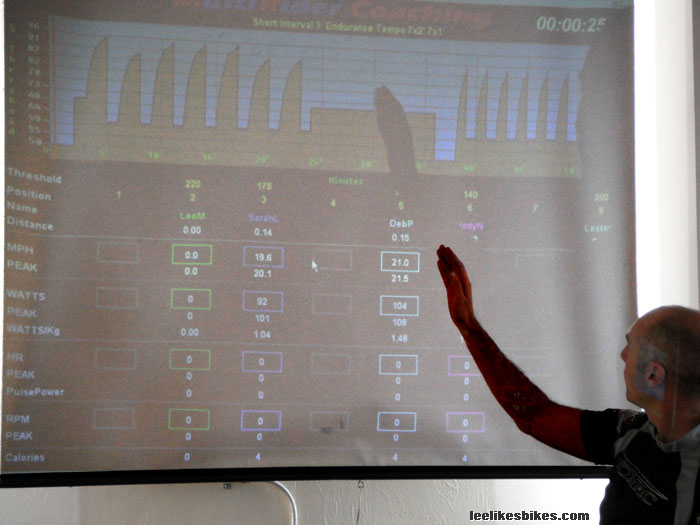One foot at a time

This week’s PowerMax indoor training session at the Boulder Center for Sports Medicine was relatively easy, but I laid down some base and learned a little something about one-footed pedaling.
Quick definition
Threshold power is the amount of power you can sustain for an hour. It’s the main indicator of your long-term pedaling performance. An elite road racer can belt out 500 watts. I can maintain about 240.
All PowerMax workouts are based on your threshold power. The coach specifies what percentage of your threshold you should be producing at any moment, and the machinery adjusts to keep you in the right zone.
Whew!
Last Wednesday’s threshold intervals and over-exuberant sprints demolished me. Tuesday’s three-hour hike/ride blew me out. I showed up this Wednesday tired, dehydrated and ready for another beat down.
Luckily, this was a pretty easy protocol:
– Seven 2-minute intervals near threshold power
– 12 minutes of low-resistance pedaling drills
– Seven 1-minute intervals near threshold power
 Lester explains that the Loch Ness Monster might appear during the rest period. That would be a good time to sprint. |
Coach Lester Pardoe is building our bases, gradually exposing us to more and more time at threshold power. In a few months our threshold intervals will be much longer, and we’ll be spending more time above threshold. This will increase our thresholds, and it’ll make us more comfortable closer to red line. Don’t worry: I shall rule the Super D kingdom with benevolence.
I did the prescribed work — with no show-off sprinting action — and it felt easy. Maybe I should increase my threshold power? Naw …
One foot at a time
During our “off” phase, Lester had us pedal with one foot for 30 seconds, the other foot for 30 seconds, both feet for 30 seconds (repeat).
I actually do a fair amount of one-footed pedaling, usually on the climb to my house. That’s very low cadence, and I focus on applying power all around the stroke. I alternate 10 strokes on each side. It seems to work OK.
Wednesday’s drills were at much lighter resistance and higher cadence. I tried to pull up on the upstroke, and it basically sucked. After maybe 15 seconds my hip flexors and the fronts of my ankles burned, and my stroke got clunky and junky.
Lester suggested we focus on pushing across the top of the stroke. No scraping mud at the bottom. No pulling up. None of that business. Just drop your heel, push across the top and make the power stroke as long as possible. Just like with both legs.
That was much better. Duh. I wonder if I can do this with flat pedals.
Riders’ choice
When only five one-minute intervals remained in the workout, Lester said, “We have five intervals and five people. Each of you gets to choose what we do.”
The other riders had us do things like: faster cadence than normal; 30 seconds fast, 30 seconds slow; standing the whole way.
My choice: 5 seconds pinned out of the saddle, 10 seconds cycling up and down in attack position as if you’re pumping bumps (repeat)
That was fun, and it felt more like mountain biking.
Expecting a beat down next Wednesday.
Know more. Have more fun!
Join the leelikesbikes mailing list:

Comments are closed.